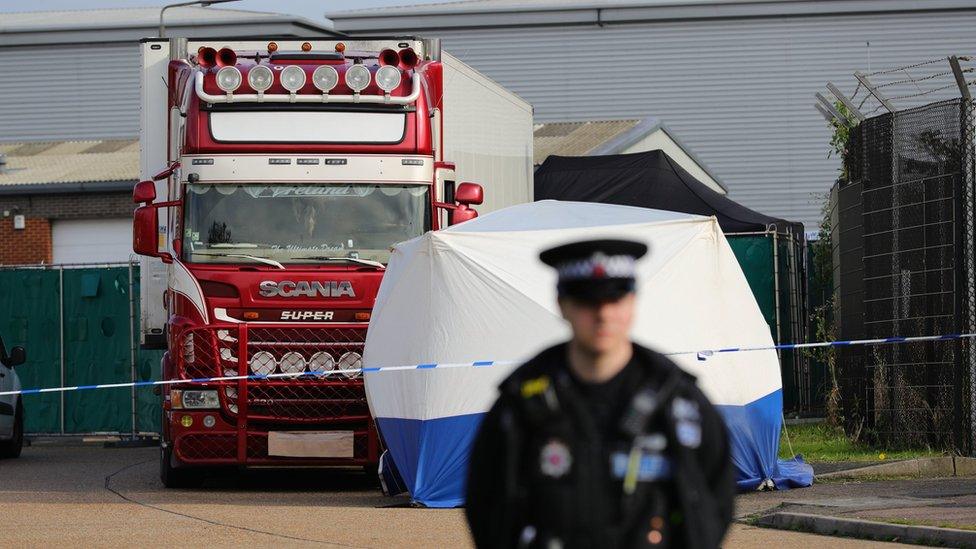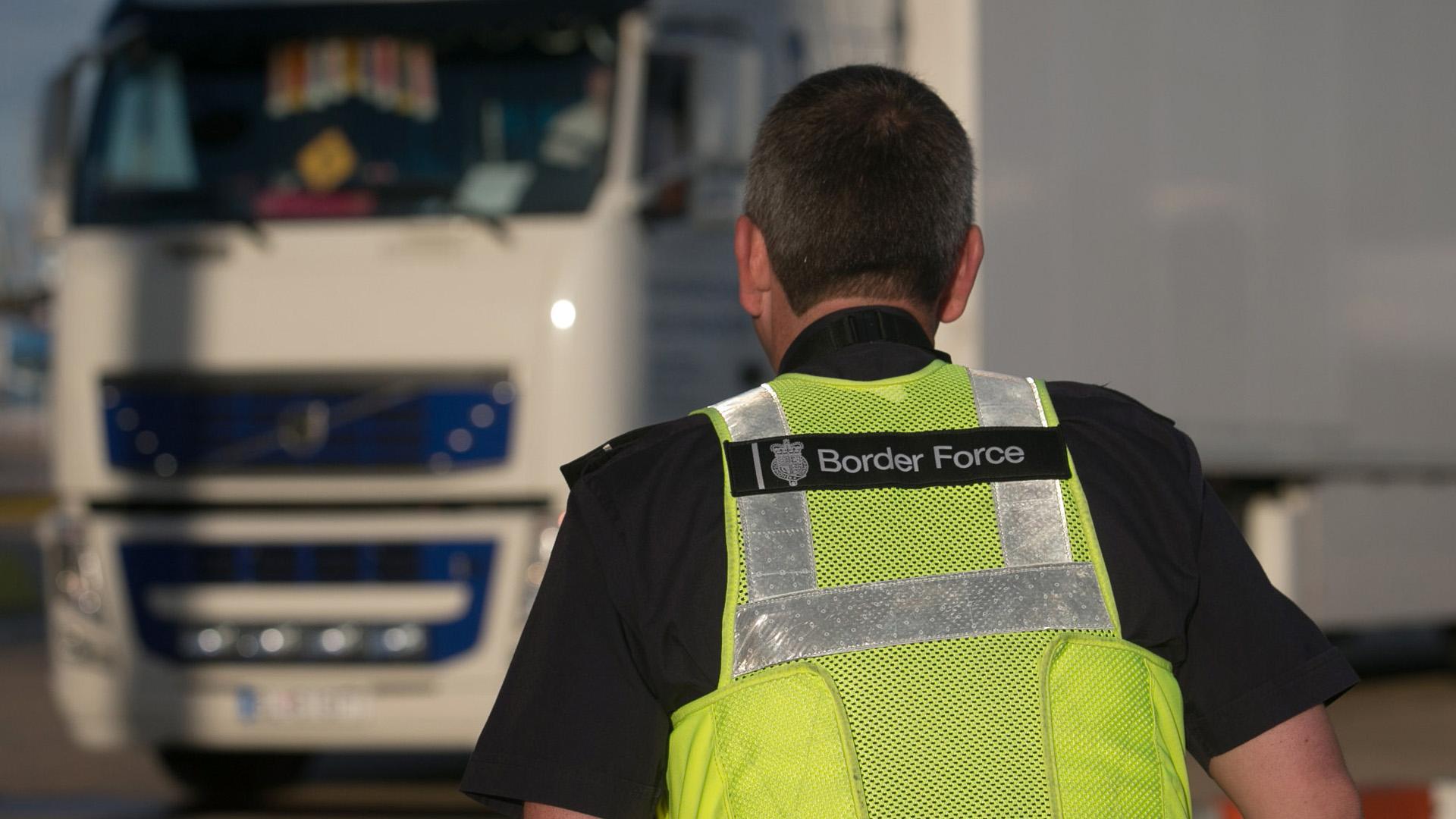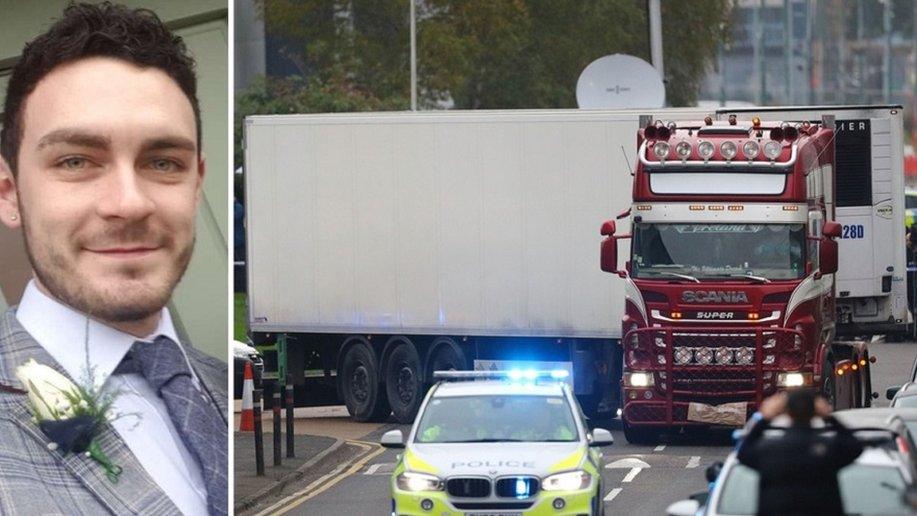Essex lorry deaths: What security is at UK's ports?
- Published

Police are working to identify the bodies of 39 people found in a lorry in Essex.
It is thought the vehicle came into the UK from the Belgian port of Zeebrugge, a known route for people smuggling., external
Why are some ports unmanned?
The lorry container in which the bodies were discovered arrived in the UK through the port of Purfleet, on the River Thames.
It is among a number of the "less busy" ports which, according to the National Crime Agency (NCA), smugglers have been using more often. Other east coast ports identified by the NCA as being used to illicitly bring in migrants include Tilbury, also in Essex, and Hull.
A further 62 smaller east coast ports and landing places were "normally unmanned", a report from the UK's border inspectorate said in 2016, external.
It said that Border Force officers had not attended 27 of the 62 during the 15 months to 30 June 2016.
The UK has agreements which allow its own border agents to carry out checks at certain ports in France or Belgium. This means they can inspect vehicles before they cross.
But not all ports are covered, with the focus on major entry points, like Calais in France, or Brussels Midi Eurostar station in Belgium.
A lack of staffing and resources, including vehicle scanners, at east of England ports was highlighted by the border inspectorate's report, external.
Technology, like scanners and heartbeat and carbon dioxide detectors, have led to the discovery of people concealed in lorries and containers in the past.
In 2013, the last official figures available, 268 "clandestine entrants" were detected by UK agents using scanners.
How do people arrive illicitly in the UK?
Since the closures of migrant camps in France, in 2016-17, there have been fewer "opportunistic" attempts to enter the UK by individuals.
But more Channel crossings are being co-ordinated by organised criminal gangs, according to the UK's National Crime Agency, external.
And during 2018, there was an increase in "higher risk methods of clandestine entry".
This includes transporting people in containers and refrigerated vehicles - such as the container found in Essex.

How many people arrive illegally?
The number of people arriving in the UK illicitly is, by its nature, hard to measure.
Police forces do compile figures on people arrested for illegally entering the country, but these are not routinely published.
However, an investigation by BBC News found there were 27,860 arrests for illegally entering the UK between 2013 and April 2016.
In the same period, there were 2,482 arrests for helping people enter the UK.
The total number of people living in the UK illegally, external has been estimated at anything from about 300,000 to 900,000 - but these estimates are very uncertain.
The Office for National Statistics (ONS) says that there are currently no up-to-date estimates.
"Due to the challenges in making reliable estimates the government has not produced any official estimates since the mid-2000s," it said in June.
How many migrants have died in transit in the UK?
Before this tragedy, five people had been found dead in or on lorries or containers in the UK, since figures started being collected, in 2014.
It is thought they died while being smuggled to their intended destination or after stowing away.
2014: An Afghan migrant was found dead at Tilbury Docks, Essex. He was in a shipping container, with 34 Afghans who survived
2015: Two migrants were found dead in a wooden crate in a warehouse in Branston, Staffordshire. The crate had been sent from Italy in a container
2016: An 18-year-old migrant was crushed clinging to the underside of a lorry in Banbury, Oxfordshire
2016: A body was found in the back of a lorry in Kent, which had travelled from France
Data was not collected in the same way before 2014, but these kind of tragedies are not new.
In 2000, 58 Chinese migrants were found suffocated, external in a lorry at Dover. The driver was found guilty of manslaughter and sentenced to 14 years in jail.
How many deaths have there been elsewhere in Europe?
The UN's International Organisation for Migration, external started recording deaths such as these in 2014, following a surge in migration to Europe from the Middle East.
In 2015, 71 people suffocated in the back of a lorry in Austria.
Other incidents have seen vehicles smuggling migrants involved in serious accidents, such as a 2016 minibus crash that killed nine people from Pakistan and Afghanistan.
The UN estimates 491 people have died or gone missing crossing Europe since early 2014.
The most common causes of death are car and train accidents. About 10 people have been killed in or around the entrances to the Channel Tunnel.
The numbers are collected through a mixture of charity, international organisation and media reports. They do not include deaths in migrant camps or detention centres.
Nor do they include the estimated 18,500 people who have died, or gone missing, crossing the Mediterranean.
A note on terminology: The BBC uses the term migrant to refer to all people on the move who have yet to complete the legal process of claiming asylum. This group includes people fleeing war-torn countries, who are likely to be granted refugee status, as well as people who are seeking jobs and better lives, who governments are likely to rule are economic migrants.
- Published23 October 2019

- Published11 September 2018
